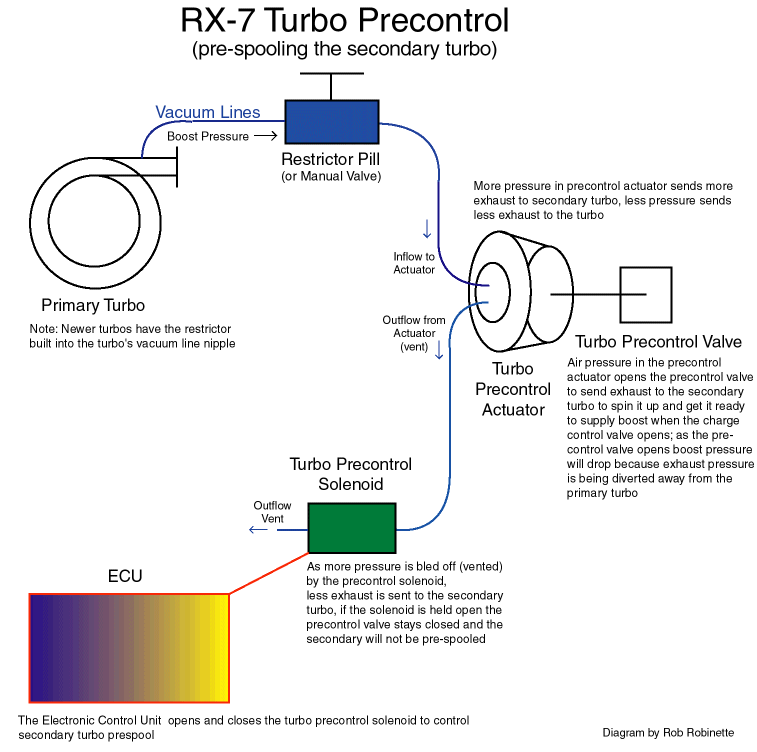How to Install a Manual Boost Controller
(and secondary turbo pre-spool controller)
By Rob Robinette
How the RX-7 Controls Boost
The 3rd gen RX-7 uses an "open loop," non-feedback boost controller. Air pressure in the wastegate actuator controls boost, the more pressure it sees the more the wastegate opens which lowers boost. Airflow "in" to the wastegate actuator is regulated by a restrictor pill and airflow "out" of the wastegate actuator is regulated by a solenoid controlled by the ECU. The stock 10 psi boost pressure is factory set with a restrictor pill in the vacuum hose between the primary turbo and the wastegate control actuator. The ECU blindly opens and closes the wastegate control solenoid at a preset rate to bleed off pressure at the wastegate control actuator to raise boost (see the diagram below).
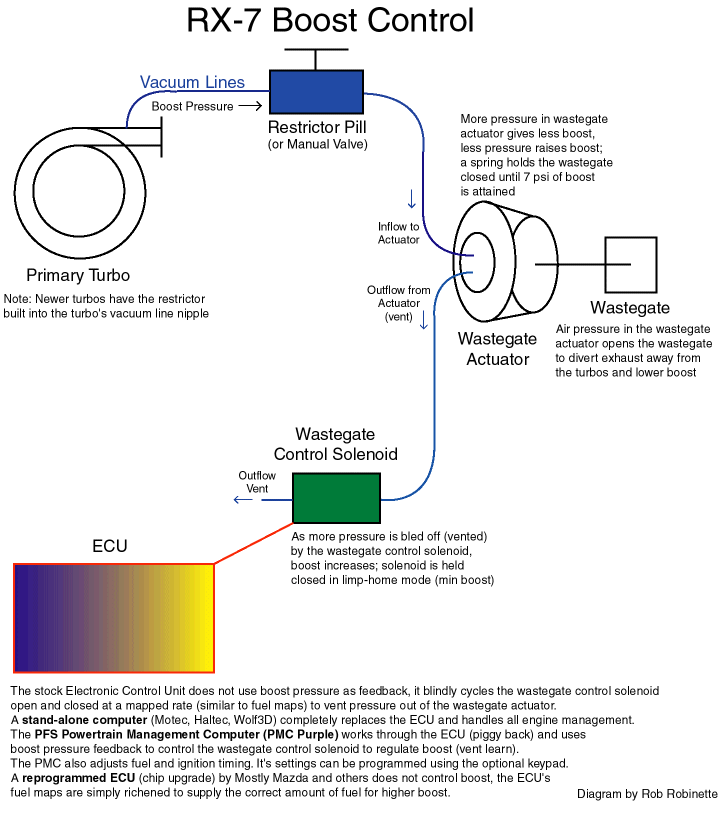
Note: On newer cars and turbos the restrictor pill may be replaced by a restricted vacuum line nipple on the primary turbo. If that is the case then you will need to "drill out" the nipple to reduce restriction. If you don't reduce the restriction you will not be able to lower boost.
After-market electronic boost controllers such as the PRofec and EVC are spliced into the vacuum line that has the boost restrictor pill (see diagram below). They regulate boost by controlling the air pressure in the wastegate actuator. The wastegate actuator's outflow nipple is plugged and all air coming into and out of the wastegate actuator is controlled by the PRofec or EVC. The PFS PMC does not have a separate boost controller. It works through the ECU to control the wastegate control solenoid to raise and lower boost. It differs from the stock boost control setup in that it does use boost pressure as feedback and then adjusts the rate that the wastegate control solenoid bleeds off wastegate actuator pressure.
The amount of exhaust that is diverted to the secondary turbo to get it spun up before it comes on line around 4500 rpm is also controlled by a vacuum line restrictor. See the Vacuum Hose Diagram (lower left corner of diagram) or this Turbocharger Cutaway for the location of the restricted hoses and wastegate actuator.
A Manual Boost Controller
As you modify your RX-7 by opening the intake and exhaust, your boost will rise unless you reduce the restriction of the boost control vacuum line. By replacing the restrictor pills with needle valves you can control the boost level and amount of pre-spool the secondary turbo receives (which causes the boost spike at 4500 rpm). For a much more detailed description of how the RX-7 controls boost see the Boost Control Page.
What's Needed
Valves: Home Depot part # PB9106-CP, it's called a "1/4" Tube to Tube valve W/Insert," available in the plumbing department
3 inches of 1/4 inch copper or plastic tube; 7 feet of 6mm vacuum hose (3 1/2 feet for each valve); 8 small tie-wraps
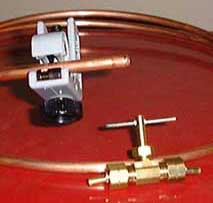
1/4 inch tubing, tube cutter and valve
This is the same boost controller as described at Brooks Weisblat's Mazda RX-7 web site except I placed the 1/4 inch needle valve in the engine compartment. You can do this mod by only removing the air box and the upper pipe that goes from the air box to the turbo. I put a three foot loop of 6mm silicone hose where the restricted hose went and after I got the air filter pipes back together I cut the 6 mm hose and installed the valve. The hose actually connects to the wastegate controller directly below the valve (pictured below). I installed a 1 1/4 inch length of copper tube in each end of the valve and slipped the 6 mm silicone hose over the copper tube and tie-wrapped it. Be sure to tie-wrap the hose ends on the turbo end of the hoses.
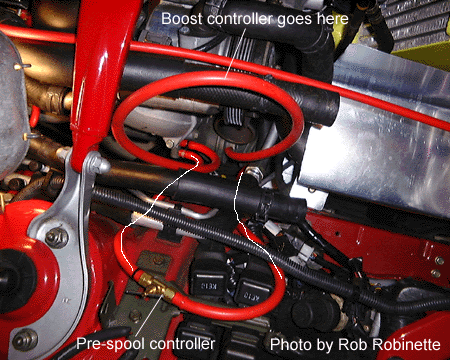
Air box and intake hoses removed
For initial setup of the boost control valve I closed the valve (don't force it) then backed it out (counter clockwise) two turns, that gave me about 8 lbs. of boost. I then closed the valve (in 1/4 turn increments) another 3/4 turn for 13 lbs. of boost. Note: You shouldn't run higher than stock boost (10 psi) until you upgrade the intercooler or you risk detonation and engine failure. See PRofec and EVC Electronic Boost Controller Install how-to.
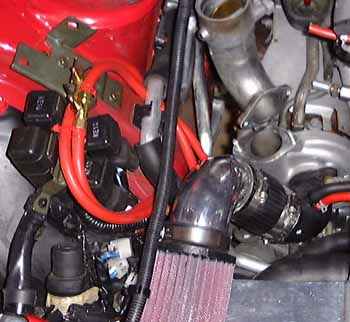
Boost and pre-spool control needle valves installed
Secondary Turbo Pre-Spool Controller
You can also replace the other restrictor in the turbo precontrol hose. If you do this you will be able to control how much the secondary turbo spools up before it comes on line. That allows you to reduce it's 4500 rpm boost spike.
I did this and it works but it takes some work to get the valve set right. I now have have a much smaller boost spike when the second turbo comes on line. I have the valve set at just a little more than 1/8 turn out from fully closed (very restrictive). The more you open it the more it pre-spools (more boost spike), the more you close it the less it pre-spools (more boost dip). Adjust it to balance the boost drop and boost spike that occurs at 4500 rpm.
This valve is much more sensitive than the boost valve. A very small turn will greatly affect the pre-spool. It is tough to get the right amount of pre-spool to balance the boost dip vs. spike. When the precontrol valve opens the boost from the primary turbo will drop because the precontrol valve acts like a wastegate, exhaust is diverted away from the primary turbo. Realize that adjusting the pre-spool will also raise and lower your primary boost because of the way the precontrol valve acts like a small wastegate. The more you open the valve (more pre-spool) the lower the primary (<4500 RPM) boost will be, close the valve and primary boost will go up. The bottom line is that there is a complex relationship between primary boost and the boost spike at 4500 RPM. If you have problems setting the pre-spool valve you can easily re-insert the restrictor pill.
I put red tie-wraps on the boost control so I could tell it apart from the pre-spool control. See the vacuum hose diagram (lower left corner of diagram) for the location of these two hoses with restrictor pills.
Rob Robinette
Tuning the Boost Control and Precontrol Valves
By Max Cooper
[comments added by Rob Robinette are in brackets]
The precontrol pill controls the spike. A pill with a bigger hole will divert more exhaust gas to pre-spooling the turbo. That gives a bigger spike.
I have had valves and no ECU, and was able to tune the system to give 10 psi across the board with only a slight drop and spike at the transition. I must warn that you need to be very careful when tuning the system because half a turn could be the difference between 10 psi and a blown motor. Start with the wastegate (boost control) valve open (lowest boost) and get to your desired boost level in steps, keeping a very close eye on the boost gauge.
[Rob adds: I started with 2 turns out from closed on the boost control valve. The more highly modified your car is the more open it should be. If you have a fully open exhaust and intake then by all means open the valve completely to start the tuning session. Make small adjustments because once the boost begins to rise it will jump several pounds with just a ¼ turn.]
It seems like you would want to start with the precontrol valve mostly closed to prevent spiking, but I seem to remember that this wasn't a problem-perhaps the wastegate was opening and preventing too much pre-spool. Anyway, your post-transition boost is used to tune the wastegate line, and then you tune the precontrol to get the spike characteristics you are shooting for. I think Gene Kan wrote up some stuff on how to tune this system. The best advice I can give you is to seek an understanding of the system first to aid in making tuning choices. Also, I think my advice here is correct, but it has been a while since I did this so don't take it as gospel.
So that's how the valves work. The problem with the valves is that their adjustability can be a liability. The fact that such a small adjustment to the valve can be the difference between prefect tune and a dead motor makes many people uncomfortable with the valves.
[The precontrol is especially sensitive to valve adjustments, I recommend you preset the valve by blowing through it and the original vacuum line with the restrictor pill and try to match the resistance level between the two; this will put you in the ballpark of the stock setup.]
Also, there has been some question about how long the valves will retain their precision in the harsh under-hood environment. Perhaps some durable, lockable valves would be the solution to both of these problems, but simply pills are also an option. [I haven't had any problem with the valves creeping from their set position.]
You can use Holley carb jets as pills. I was lucky enough to be given a whole set by my brother who stopped using Holley carbs on his race car. I recently swapped out my stock pills as I could not get more than 10 psi even with my PMC controlling boost. I installed a 0.065 pill in the wastegate line, and a 0.069 pill in the pre-control line. With these, I am now able to get all the boost I want. However, I will be putting a little smaller pill in the pre-control line to reduce the amount a spiking. This wastegate pill is almost certainly too small for the stock boost control system, and I am not sure about the pre-control pill.
One side effect of restricting the wastegate line is that you slow down the wastegate's reaction speed. That means more spiking. There may be a point where you simply cannot effectively control boost with pills and the stock system. A bigger or no wastegate pill and an electronic boost controller may be what you need.
What I suggest you do is put some long lines on the pre-control and wastegate lines and route them so that you can swap pills easily. Be careful not to add a lot of restriction (beside the pills) with pinches or restrictive splice joints. Some thin wall ¼" copper tubing and some cable ties for clamps might be the best way to add a splice joint so you can switch pills. I think your stock wastegate pill might be pretty close to what you want, so keep it to start. Using your eyes or some more precise method, select a pre-control pill that is slightly smaller than stock. Buy a couple of Holley jets around that size. Once you have found a pre-control pill that works for you, you may choose to get rid of the long lines and just use your new pill(s) in short lines for the pre-control and wastegate. However, the shorter, unspliced lines may prove slightly less restrictive than the long lines, which may lower your boost and increase the spike.
Here's what I have learned:
· The restrictor pill in the wastegate line lowers the pressure that the wastegate actuator sees. You may think it would just reduce the flow and give the same pressure, but in actuality the wastegate duty valve is letting air out which regulates the pressure. A restrictor that passes more air will mean more pressure in the wastegate actuator and thus lower boost for a given duty cycle. And the duty cycles are set in a table from the stock ECU - there is no learning or closed loop sensing AFAIK. Thus bigger hole in the restrictor equals lower boost; smaller restrictor, more boost.
· The turbo precontrol system vents some exhaust gas from the primary turbo to get the second turbo spinning before it comes on line. Too much pre-spool yields boost spikes and too little yields a big drop in boost at the changeover. A big hole in the restrictor will limit primary boost and give a big spike. A small hole in the restrictor will allow for higher primary boost, but will cause a drop in boost during the changeover.
· You can lower your boost if you replace the wastegate pill with a valve and leave the valve open. It should drop to 7 psi, which is the weight of the wastegate actuator spring.
· I think the ideal to shoot for is a smooth transition [balancing the boost drop and the boost spike]. About as close to this as you can come is a little drop and then a little spike. Of course, the reduced backpressure of post-transition operation will give a big rush of power even at the same boost level.
Max Cooper
How to Adjust the Turbo Precontrol Actuator Rod
John Levy Adds:
<Reprinted from The Drew Files>
In order to properly set the length of the turbo precontrol actuator rod remove the E-clip that fixes it to the door. Hold [pull] the door arm so that the door is completely closed. Adjust the length of the actuator rod so that the hole that fits over the pin reveals only half of the pin. When you have accomplished this you will have to use a small Vicegrip or similar tool to get some leverage on the rod to pull enough of it out of the actuator in order to place the rod's hole over the arm's pin.
Hope this helps. Cam Worth of Pettit taught me this procedure in order to eliminate reduced boost on the primary turbo. Apparently, the precontrol door can be open a crack, allowing pressure to divert to the secondary before the primary has spun up enough.
John Levy
